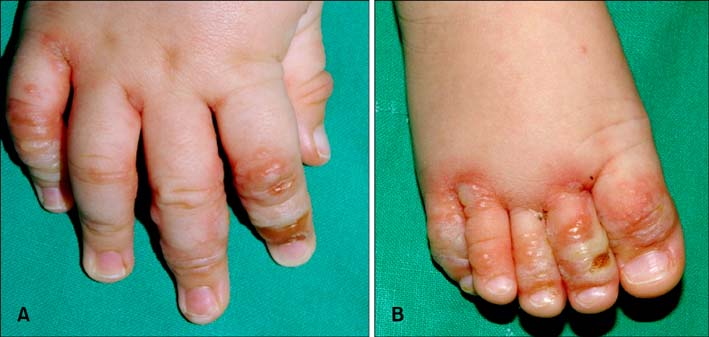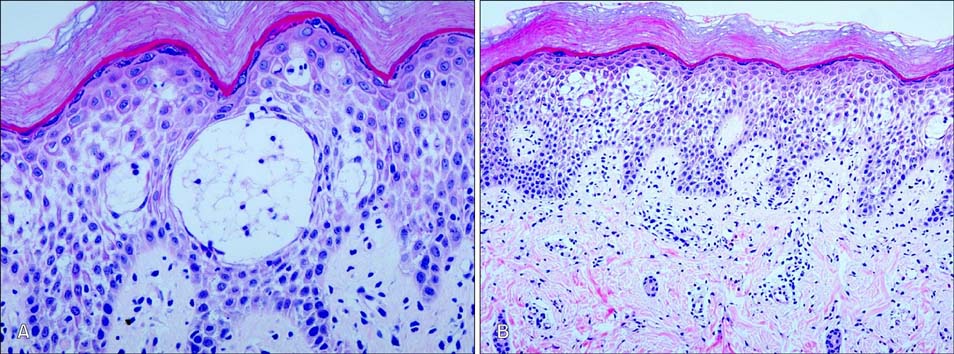Ann Dermatol.
2011 Sep;23(Suppl 1):S88-S90. 10.5021/ad.2011.23.S1.S88.
A Case of Acrodermatitis Enteropathica Localized on the Hands and Feet with a Normal Serum Zinc Level
- Affiliations
-
- 1Department of Dermatology, Yonsei University Wonju College of Medicine, Wonju, Korea. choieh@yonsei.ac.kr
- KMID: 2156760
- DOI: http://doi.org/10.5021/ad.2011.23.S1.S88
Abstract
- Acrodermatitis enteropathica is classified as a congenital autosomal recessive type and an acquired transient type. This disease manifests as acral and periorificial dermatitis, alopecia, intractable diarrhea, and failure to thrive. Whereas the autosomal hereditary type is caused by malabsorption of zinc in the intestine, the acquired type is caused by low nutritional support or decreased peripheral release of zinc from blood. We experienced a case of a 5-month old, breast feeding, full-term female presenting with only acral bullous dermatitis without diarrhea, periorificial dermatitis and an abnormal serum zinc level.
Keyword
MeSH Terms
Figure
Reference
-
1. Brandt T. Dermatitis in children with disturbances of general condition and absorption of food elements. Acta Derm Venereol. 1936. 17:513–537.2. Danbolt N. Acrodermatitis enteropathica. Acta Derm Venereol. 1951. 31:453–454.
Article3. Maverakis E, Fung MA, Lynch PJ, Draznin M, Michael DJ, Ruben B, et al. Acrodermatitis enteropathica and an overview of zinc metabolism. J Am Acad Dermatol. 2007. 56:116–124.
Article4. Lim YS, Lee MW, Choi JH, Sung KJ. The clinical study of zinc deficiency presented as a skin manifestation of acrodermatitis enteropathica. Korean J Dermatol. 2000. 38:155–162.5. Aggett PJ. Acrodermatitis enteropathica. J Inherit Metab Dis. 1983. 6:Suppl 1. 39–43.
Article6. Krieger J, Evans GW. Acrodermatitis enteropathica without hypozincemia: therapeutic effect of a pancreatic enzyme preparation due to a zinc-binding ligand. J Pediatr. 1980. 96:32–35.
Article7. Mack D, Koletzko B, Cunnane S, Cutz E, Griffiths A. Acrodermatitis enteropathica with normal serum zinc levels: diagnostic value of small bowel biopsy and essential fatty acid determination. Gut. 1989. 30:1426–1429.
Article8. Garretts M, Molokhia M. Acrodermatitis enteropathica without hypozincemia. J Pediatr. 1977. 91:492–494.
Article9. Krieger I, Evans GW, Zelkowitz PS. Zinc dependency as a cause of chronic diarrhea in variant acrodermatitis enteropathica. Pediatrics. 1982. 69:773–777.
Article
- Full Text Links
- Actions
-
Cited
- CITED
-
- Close
- Share
- Similar articles
-
- A Case of Acrodermatitis Enteropathica with a Normal Serum Zinc Level
- A Case of Transient Acrodermatitis Enteropathica
- A Case of Acrodermatitis Enteropathica with Normal Serum Zinc Level in a Breastfed Preterm Infant
- A Case of Transient Acrodermatitis Enteropathica in A Breast-fed Full-term Infant
- A Case of Transient Acrodermatitis Enteropathica with a Normal Serum Zinc Level Localized on the Anogenital Area



